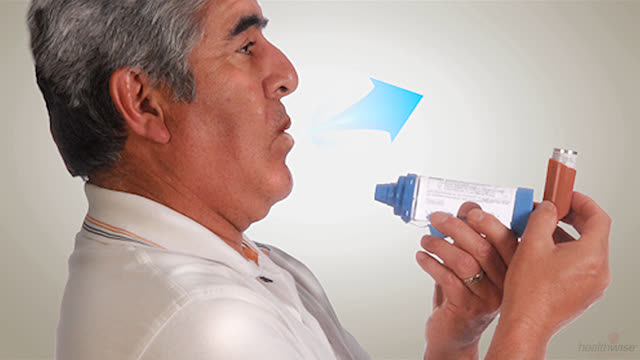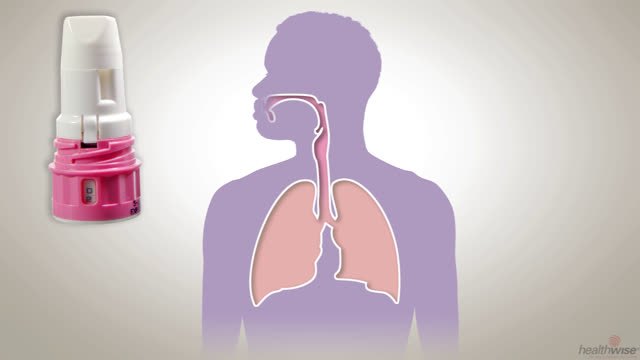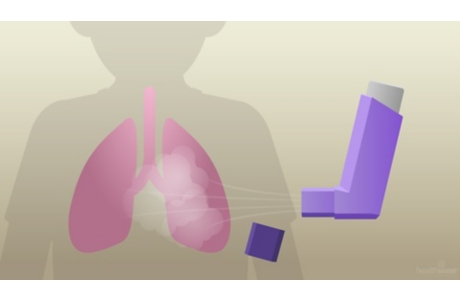Top of the pageActionset
Breathing Problems: Using a Dry Powder Inhaler
Introduction
People who have asthma or other lung diseases that make it hard to breathe may use an inhaler to get the medicine they need into their lungs. Inhaled medicine works faster than the same medicine in a pill. An inhaler also lets you take less medicine than you would if you took it as a pill.
You may have used a metered-dose inhaler in the past. But a dry powder inhaler is different. These instructions are for using a dry powder inhaler.
- A dry powder inhaler lets you breathe medicine into your lungs quickly.
- A dry powder inhaler is breath-activated. This means that when you breathe in through the inhaler, the inhaler releases the medicine into your lungs.
- Dry powder inhalers come in different shapes and sizes. For some, you need to add the medicine to the inhaler each time you use it. Other dry powder inhalers come with a supply of medicine already in them. But for these, you will need to “load” each dose of medicine each time you use it. How you load a dose depends on the type of inhaler you have.
How to use a dry powder inhaler
Things to know before you start
- Talk with your doctor, respiratory therapist, or pharmacist to make sure that you are using your inhaler the right way. It may help to practice in front of a mirror. Use the inhaler exactly as prescribed.
- Keep your inhaler in a cool, dry place. Do not store your inhaler in the bathroom. Moisture in the air can cause the dry powder to clump together and clog the inhaler.
- Keep track of how much medicine is in the inhaler. Some dry powder inhalers have dose counters that show how many doses are left in the inhaler. If your inhaler does not have a dose counter, your doctor or pharmacist can teach you how to keep track of how much medicine is left.
- Follow your doctor’s or pharmacist’s instructions for cleaning your inhaler. Some powder may build up on the inhaler, but you don’t need to clean it every day.
- You may have other inhalers that you use for different medicines. If one of them is a metered-dose inhaler (which sprays out a mist of liquid medicine), you might be using a spacer with it. But you should not use a spacer with a dry powder inhaler.
Using a dry powder inhaler
Follow these steps for using a dry powder inhaler:
- Check that you have the correct medicine. If you use several inhalers, put a label on each one so that you know which one to use at the right time.
- Remove the inhaler cap, if there is one.
- Add or load a dose of medicine as directed by your health care provider.
- Tilt your head back a little, and breathe out slowly and completely. Hold the inhaler away from your mouth when you breathe out. Do not breathe out into the inhaler. This can blow some of the powder out of the inhaler. Also, the moisture in your breath can cause the dry powder to clump together and clog the inhaler.
- Place the inhaler in your mouth, and close your lips tightly around the mouthpiece.
- Inhale quickly and deeply through your mouth for 2 or 3 seconds. This pulls the powder from the inhaler into your lungs. After you have inhaled the powder, take the inhaler out of your mouth.
- Hold your breath for 10 seconds. This will let the medicine settle in your lungs. Then slowly breathe out through pursed lips. Make sure not to breathe out into the inhaler. Repeat steps 1 through 7 if you need to take a second dose.
- If you are using an inhaler with corticosteroid medicine, gargle and rinse out your mouth with water after you use the inhaler. Do not swallow the water. Swallowing the water will increase the chance that the medicine will get into your bloodstream. This may make you more likely to have side effects from the medicine.
Credits
Current as of: June 9, 2019
Author: Healthwise Staff
Medical Review:E. Gregory Thompson, MD – Internal Medicine & Adam Husney, MD – Family Medicine & Martin J. Gabica, MD – Family Medicine
Current as of: June 9, 2019
Author: Healthwise Staff
Medical Review:E. Gregory Thompson, MD – Internal Medicine & Adam Husney, MD – Family Medicine & Martin J. Gabica, MD – Family Medicine
This information does not replace the advice of a doctor. Healthwise, Incorporated, disclaims any warranty or liability for your use of this information. Your use of this information means that you agree to the Terms of Use. Learn how we develop our content.





